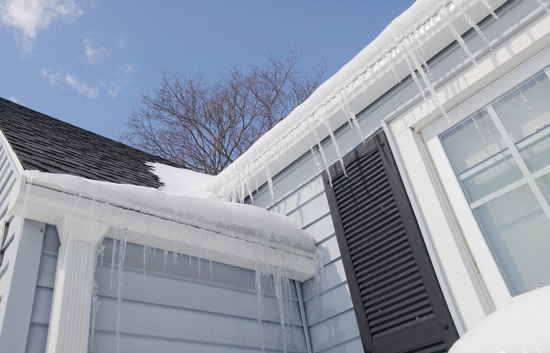|
Your roof has the important job of protecting your home from the elements, but winter can be tough on the shingles and other roofing structures. The winds are strong, the snow is heavy, and ice can build up surprisingly quickly. To keep damage at bay and avoid the cost and hassle of repairs, there are some preventative steps you can take during the winter months.
Remove Snow When It Gets Too Deep
Roofs can generally stand up under quite a bit of snow, but how much is too much? As a good rule of thumb, you should remove snow once it piles higher than 20 cm (8 in). You can also consult with a structural engineer to get a more accurate estimate for your own home. It is important to remove deep snow because it creates excess weight on your roof, which can lead to a deformed ceiling, cracks on your inner walls, and even difficulty closing and opening doors and windows.
Tips for Removing Snow Safely
The best way to remove snow from your roof is with a roof rake or a telescopic shovel. This allows you to keep your feet firmly planted on the ground, and it will help prevent damage to your roof as well. If you have to use a ladder to reach the snow, make sure you have someone else with you to hold it steady.
Inspect and Clean the Gutters
Cleaning the gutters is an important fall maintenance task, and you may need to check and clean them again during the winter if you notice problems with drainage. If the water flow is blocked, your roof may develop leaks or ice dams, which can lead to leaks and other types of roof damage as well. Ice dams occur when too much ice builds up on the edge of the roof caused by snow melting and freezing.

Inspect Your Attic Ventilation
A common contributing factor to the formation of ice dams is poor attic airflow. The attic should be both well-insulated and have proper routes for ventilation. If you are noticing the buildup of too much ice on your roof, poor insulation is a likely culprit. Inspect your attic for sufficient insulation and consider upgrading if it is not of adequate amount or quality. An investment in better insulation can save you on the price of costlier repairs.
Check for Damage After a Storm
Winter conditions are extreme, and damage can occur even if you do your best to prevent it. It’s a good idea to perform an inspection of your roof and attic after a winter storm. Wind is usually the biggest culprit, as it can damage or rip shingles and other roofing materials off completely. If you do notice any damage, you should get it fixed up as soon as possible, as these new weak spots can quickly lead to roof leaks.
The roof may be out of sight and easy to keep out of mind, but don’t take it for granted. Help your roof stay in good condition until spring by knowing what to look out for and how to deal with whatever winter throws your way.
|